Sétif
Sétif (Arabic: سطيف, Kabyle: Sṭif) is an Algerian city and the capital of the Sétif Province. It is one of the most important cities of eastern Algeria and the country as a whole, since it is considered the trade capital of the country. It is an inner city, situated in the eastern side of Algeria, at 270 kilometers east of Algiers, at 131 km west of Constantine, in the Hautes Plaines region south of Kabylie. The city is at 1,100 meters of altitude.
Setif سطيف | |
|---|---|
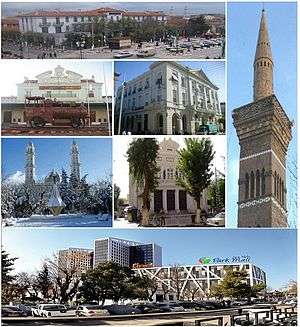 Top: Park Mall Sétif Center: Ain El Fouara Fountain – The Islamic Cultural Center – The Train Station – The Theater Bottom: Park Mall, The Ferris Wheel and The Byzantine Citadel – Jamaâ El Atik Mosque's Minaret | |
| Nickname(s): Setif The High سطيف العالي The capital of High Plains عاصمة الهضاب العليا | |
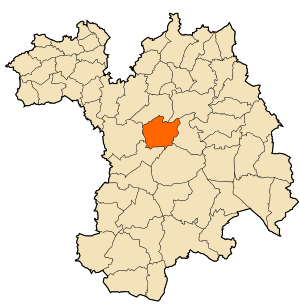 Location of Setif in the Setif Province | |
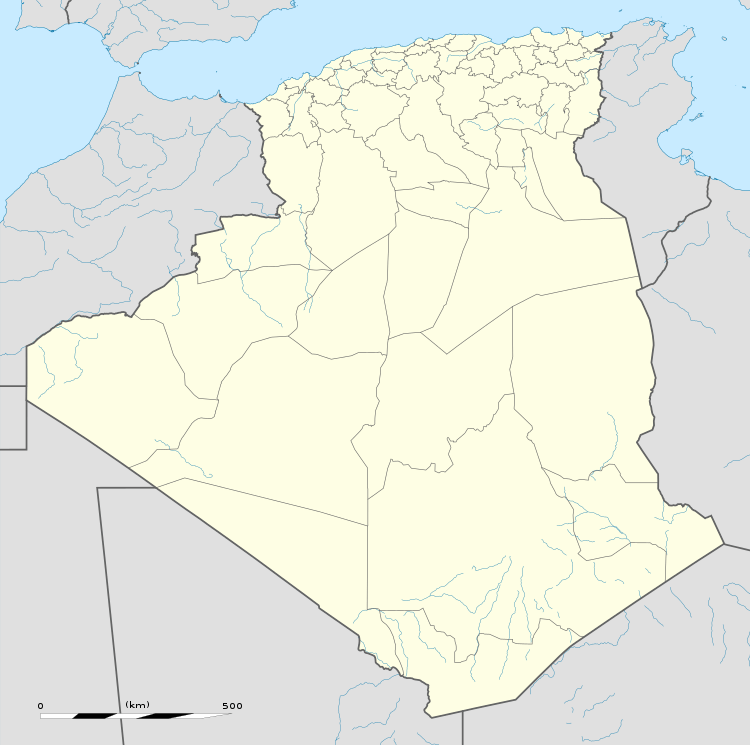 Setif Location in Algeria and Africa  Setif Setif (Africa) | |
| Coordinates: 36°11′24″N 5°24′36″E | |
| Country | |
| Province | Sétif Province |
| District | Sétif |
| Government | |
| • Body | People's Municipal Assembly |
| • Mayor | Mohamed Cherif Bourmani |
| Area | |
| • Total | 127.30 km2 (49.15 sq mi) |
| Elevation | 1,100 m (3,600 ft) |
| Population (2008) | |
| • Total | 288,461 |
| • Estimate (2019) | 788,422 |
| • Rank | 8th |
| • Density | 2,300/km2 (5,900/sq mi) |
| Demonym(s) | Setifian |
| Time zone | UTC+1 (CET) |
| Area code(s) | (+213) 036 |
| ISO 3166 code | 1901 |
The city was part of the ancient Berber kingdom of Numidia, the capital of Mauretania Sitifensis under the rule of the Roman Empire before becoming Muslim during the Muslim conquest of the Maghreb.
It is considered as the starting point of the May 8th, 1945 protests, which was a crucial factor to the start of the Algerian War.
Toponomy
Sétif was numid before undergoing Roman rule. The name of Sétif is not drawn from Latin, but it is a Berber word "Zdif", which means "black lands", referring to the fertility of its lands. Occupying a strategic position (western gateway to the highlands of Constantine) and a major water point thanks to its water table, located at the foot of the mountains on the threshold of a vast plain, Sétif, with all its advantages, was a point of strategic crossing between the eastern part and the western part of Algeria. Sétif was part of the messasylian kingdom, and in the year 225 BC, it was the capital of a Berber kingdom, a title it lost when Juba preferred Cherchel. It was near Sétif that Jugurtha fought a great battle at Caius Marius.
Geography
Sétif is the capital of Sétif Province, and it has a population of 288,461 inhabitants as of the 2008 census. It is located 270 kilometers east of Algiers, 65 km from Bordj Bou Arreridj and 132 km from Constantine in the Hautes Plaines region south of Kabylia, the city is located 1,096 m (3,596 ft) above sea level, making it the second highest capital of a province in Algeria.
History
Numidia
The city lay in the region of the Numidian kingdom of Massaesyles. It was near Sétif that Jugurtha campaigned and lost against Marius in 105 BC. Overcome by Marius, he was taken to Rome where was executed in the prison of Tullianum. No remains of this period have been found. The city was small under the Numidian kings.
Roman Era
Setifis (or Sitifis) was founded by the Romans, during the reign of Nerva (AD 96 to 98), as a colony for veterans. Although no buildings of this period are known, a cemetery excavated in the 1960s seems to have contained tombs from the early colony.[1]
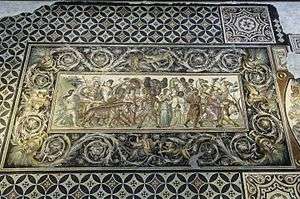
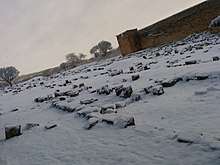
The Romans built a circus at Sitifis, which aerial photographs show survived substantially intact until the 20th century; today only a small part of the curved end continues visible; the remainder has been destroyed or built over. As the town grew, around 297AD, the province of Mauretania Sitifensis was established, with Sitifis as its capital.[2]
When Mauretania Sitifensis was created, at the close of the 3rd century, Sitifis became its capital. In the newly prosperous town a bath building was built, decorated with fine mosaics: its restoration in the fifth century had a cold room (frigidarium) paved with a large mosaic showing the birth of Venus.[3] On the northwest edge of the town two great Christian basilicas were built at the end of the fourth century, decorated, again, with splendid mosaics,[4] and a Bishopric was founded at this time. There was a Jewish community in the area.[5] In the 5th century it suffered from a violent earthquake.[6]
Although we do not know what happened under Vandal rule, the Byzantine conquest brought with it a major fort, of which parts are still standing.
Under the Vandals it was the chief town of a district called Zaba. It was still the capital of a province under Byzantine rule and was then a place of strategic importance. The area came under Byzantine control for a short period which saw the introduction of Orthodox doctrines to the mainly Donatist and Catholic town.[7][8]
Byzantine Era
In 531, the king of the Vandals, Hilderic, was overthrown by the usurper Gelimer, giving the Roman emperor of the East Justinian, anxious to restore the Roman Empire, a pretext for intervention. After his departure from Byzantium (Constantinople / Istanbul), General Belisarius took advantage of uprisings in Tripolitania and the Moors, which enabled him to take Carthage (533) and then Gelimer himself (534). The Byzantines found in Sitifis, a small population, because of the vandal predations. In 539, Sitifis again became the capital of a Byzantine "Roman" province: Mauritania Sitifensis. At that time, Solomon built the Byzantine fortress walls, whose west and south walls are still visible.

Bishopric
The city was the base of a Bishopric.[9] Augustine, who had frequent relations with Sitifis, tells us that in his day the Bishopric had a monastery and an episcopal school. Several Christian inscriptions have been found there, one of 452 mentioning the relics of Saint Lawrence, another naming two martyrs of Sitifis, Justus and Decurius.
- Known Bishops
- Servus, mentioned in a letter of St. Augustine in 409
- Novatus present at the Council of Carthage (484),[10] and exiled by Huneric
- Optatus, at the Council of Carthage (525).
- Alexis Lemaître, M. Afr. (24 Feb 1911 Appointed – 28 Jul 1920
- Joanny Thévenoud, M. Afr. (8 Jul 1921 Appointed – 16 Sep 1949)
- André-Maurice Parenty (9 Mar 1950 Appointed – 23 Nov 1983)
- Armando Xavier Ochoa (23 Dec 1986 Appointed – 1 Apr 1996)
- Manuel Felipe Díaz Sánchez (27 Feb 1997 Appointed – 4 Apr 2000)
- John Choi Young-su (22 Dec 2000 Appointed – 3 Feb 2006)
- Broderick Soncuaco Pabillo (24 May 2006 Appointed – )
Arabization
In 647 AD (the year 27 of the Hegira), the first Muslim expedition to Africa took place. By 700 AD, the area had been conquered and converted to the Islamic faith. We know little of the early Islamic town, but by the tenth century the area outside of the fortress was once more filled with houses: on the site of the Roman baths over twelve of these were excavated, with large courtyards surrounded by long, thin, rooms.[11] After conquering Cairo, the Fatimids abandoned Tunisia and parts of eastern Algeria to the local Zirids (972–1148).[12] The invasion of Ifriqiya by the Banu Hilal, a warlike Arab tribes encouraged by the Fatimids of Egypt to seize North Africa, sent the region's urban and economic life into further decline.[12]
Similar to an army of locusts, they destroy everything in their path.
Colonization
._-_Grand_H%C3%B4tel_de_France..jpg)
In the mid-eleventh century this development stopped abruptly, and a defensive wall was built around the city. Nothing more is known of Sétif until the ruins of the town were used by the French army, who built their own fortress on the site in 1848, using the line of the medieval city wall and the Byzantine fortress.
On 8 May 1945, the day of the formal end of World War II in Europe, an uprising against the occupying French forces in Sétif and the nearby towns Guelma and Kherrata resulted in the deaths of 104[14] pieds-noirs. The uprising was suppressed through what is now known as the Sétif massacre. Estimates of Algerian casualties vary widely from 2,000 to 40,000 (see Sétif and Guelma massacre).
Economy
The local economy deals both with trade and industries. The trade is mainly in grain and livestock from the surrounding region. Locally produced wheat is processed by local factories to produce semolina, couscous and noodles. Other industries are woodworking, manufacture of carpets and metal handicrafts. Zinc is extracted from nearby deposits and there are hydroelectric development to the north. It has become the commercial center of a region where textiles are made, phosphates are mined and cereals grown. Home to the Sétif tramway, this is the first city in Algeria's Kabylia region with a light rail system.

Climate
Sétif has a semi-arid climate (Köppen climate classification BSk). Its summers are hot and dry, while its winters are cool with low-moderate rainfall.
Due to Sétif's location on the High Plateaus at an elevation of 1,096 metres (3,596 ft), it is one of the coldest regions during winter in Algeria. The Wilayah frequently sees an annual snowfall of up to 40 centimetres (16 in). Flash floods are rare but have recently occurred around the spring and fall seasons. The summer is fairly hot where extreme heat waves are common around the month of July where temperatures can sometimes even reach 40 °C (104 °F).
| Climate data for Sétif | |||||||||||||
|---|---|---|---|---|---|---|---|---|---|---|---|---|---|
| Month | Jan | Feb | Mar | Apr | May | Jun | Jul | Aug | Sep | Oct | Nov | Dec | Year |
| Record high °C (°F) | 21.5 (70.7) |
21.6 (70.9) |
28.0 (82.4) |
29.1 (84.4) |
38.4 (101.1) |
39.3 (102.7) |
40.4 (104.7) |
40.2 (104.4) |
39.0 (102.2) |
33.0 (91.4) |
26.4 (79.5) |
21.8 (71.2) |
40.4 (104.7) |
| Average high °C (°F) | 10.0 (50.0) |
11.7 (53.1) |
15.0 (59.0) |
17.4 (63.3) |
23.5 (74.3) |
29.4 (84.9) |
33.4 (92.1) |
32.9 (91.2) |
27.2 (81.0) |
21.7 (71.1) |
14.7 (58.5) |
10.7 (51.3) |
20.6 (69.2) |
| Average low °C (°F) | 1.3 (34.3) |
1.9 (35.4) |
4.1 (39.4) |
5.8 (42.4) |
10.7 (51.3) |
15.3 (59.5) |
18.7 (65.7) |
18.9 (66.0) |
14.8 (58.6) |
10.8 (51.4) |
5.3 (41.5) |
2.3 (36.1) |
9.2 (48.5) |
| Record low °C (°F) | −10.5 (13.1) |
−8.3 (17.1) |
−5.5 (22.1) |
−4.5 (23.9) |
−1.3 (29.7) |
1.1 (34.0) |
8.0 (46.4) |
8.0 (46.4) |
4.5 (40.1) |
0.6 (33.1) |
−5.5 (22.1) |
−8.7 (16.3) |
−10.5 (13.1) |
| Average precipitation mm (inches) | 36.7 (1.44) |
25.6 (1.01) |
34.6 (1.36) |
42.4 (1.67) |
43.2 (1.70) |
23.5 (0.93) |
17.7 (0.70) |
13.4 (0.53) |
42.8 (1.69) |
30.5 (1.20) |
36.4 (1.43) |
45.0 (1.77) |
391.8 (15.43) |
| Average snowy days (≥ 1 cm) | 3 | 3 | 2 | 1 | 0 | 0 | 0 | 0 | 0 | 0 | 0 | 2 | 11 |
| Source: Meoweather [15] | |||||||||||||
Soccer team
The ES Sétif Soccer Team is one of Algeria's most prestigious top division clubs.
Notable people
- Faris Khenniche, footballer
References
- R. Guéry, 1985, La Necropole orientale de Sitifis: fouilles de 1966–1967. Paris.
- Francois Decret, Early Christianity in North Africa (James Clarke & Co, 2011) p. 2.
- E. Fentress, ed., Fouilles de Sétif 1977–1984 BAA supp. 5, Algiers, 29–92
- P.-A. Fevrier, Fouilles de Sétif: les basiliques chrétiennes du quartier nord-ouest Paris, 1965.
- Francois Decret, Early Christianity in North Africa (James Clarke & Co, 2011) p13
- Augustine, Ep., lxxxiv; Serm., xix.
- "The Last Christians Of North-West Africa: Some Lessons For Orthodox Today". orthodoxengland.org.uk. Retrieved 2016-03-27.
- Francois Decret, Early Christianity in North Africa (James Clarke & Co, 2011) p. 196.
- Francois Decret, Early Christianity in North Africa (James Clarke & Co, 2011) p. 84.
- Augustine letter 84.2.
- E. Fentress, ed., Fouilles de Sétif 1977–1984 BAA supp. 5, Algiers, 114–151
- Stearns, Peter N.; Leonard Langer, William (2001). The Encyclopedia of World History: Ancient, Medieval, and Modern, Chronologically Arranged (6 ed.). Houghton Mifflin Harcourt. pp. 129–131. ISBN 0-395-65237-5.
- "François Decret, Les invasions hilaliennes en Ifrîqiya – Clio – Voyage Culturel". www.clio.fr. Retrieved 2015-11-21.
- Setif & Djemila, Morocco, Algeria & Tunisia, Geoff Crowther & Hugh Findlay, editors, Lonely Planet, April 1992, 2nd Edition, p. 296.
- "Sétif average weather by month". Meoweather. Retrieved 2013-03-06.
Further reading
- Boucif Mekhaled, Chronique d'un massacre : 8 mai 1945, Sétif-Guelma-Kherrata, éd. Syros, Paris, 1995
- Jean Louis Planche, Sétif 1945. Histoire d'un massacre annoncé, éd. Perrin, 2006
- Roger Vétillard, Sétif. Mai 1945. Massacres en Algérie, éd. de Paris, 2008
- Eugène Vallet, Un drame algérien. La vérité sur les émeutes de mai 1945, éd. Grandes éditions françaises, 1948
- Denise Morel, Sétif de ma jeunesse, éd. Gandini, 2001
External links
| Wikivoyage has a travel guide for Sétif. |

- Herodote
- Femme Sétifienne المرأة السطيفية Femme Sétifienne Staifia
.svg.png)